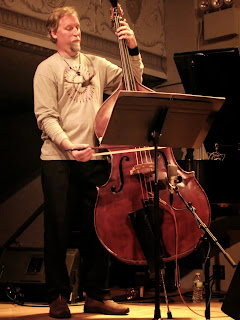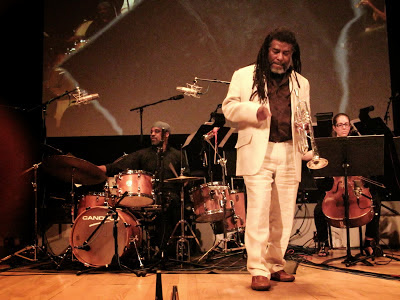A poem by Langston Hughes
As I Grew Older
It was a long time ago.
I have almost forgotten my dream.
But it was there then,
In front of me, Bright like a sun-
My dream.
 And then the wall rose,
And then the wall rose,
Rose slowly,
Slowly,
Between me and my dream.
Rose until it touched the sky-
The wall.
Shadow.
I am black.
I lie down in the shadow.
No longer the light of my dream before me,
Above me.
Only the thick wall.
Only the shadow.
My hands!
My dark hands!
Break through the wall!
Find my dream!
Help me to shatter this darkness,
To smash this night,
To break this shadow
Into a thousand lights of sun,
Into a thousand whirling dreams
Of sun!
The following is a verbal
collage of how I have absorbed Ten
Freedom Summers by Wadada Leo Smith. Reviewing this composition, having
heard both the Roulette performance in May 2013 in New York and the Los Angeles
premiere in October of 2011 and a sampling of the entire six hour piece in
between is a moot point at this point for me. So much has already been written
since it was premiered. I do not need to indulge in commenting on the
excellence of the musicians and the excellence of the music they play. I do not
need to impose the view on the music that it is not jazz, nor classical, nor
“third-stream,” nor contemporary “third stream.” Ten
Freedom Summers defies labeling. Ten
Freedom Summers is a work of art that knows no bounds in its meaningfulness
and is, therefore, an apotheosis of the articulation of a dedicated purpose lying
on the crest of one man’s spiritual and artistic being.

The music that is Ten Freedom Summers exists apart from
music which is extemporaneous. The music is scored traditionally, multiple black
books titled on the front covers in silver pen. The music of Ten Freedom Summers has been literally composed
over Wadada’s lifetime: a lifetime that was filled with personal struggles and
personal choices about which he remains reticent, but which were experiences that
shaped the composer’s fearlessness.
The bond that Smith has with
his music shall never wane.
Memories of the music
measure the sensitivity of our hearts.
Memories of the music paint
portraits of themselves.
Memories of the performance
paint portraits of determination.
Dare we appreciate the
history that feeds the music and express compassion for the inhabitants of that
history? Smith points to the very moments we need to think about; what we do
with the thoughts about those moments is up to us. Do we cry? Do we wonder why
they happened? Do we take action to follow up on or rectify the actions that
were being taken?
Do we become stronger and
offer our talents for healing wounds, heightening awareness, creating
community, pursuing the change which will degenerate the bad-ness, cruelty,
thoughtlessness, lack of initiative.
Or do we remain weak and
passive and complain. And only stand on the sides of the oppressed, whom we
might not believe really are, but who continue to be treated poorly, impolitely
and ignored, as if not even alive.
Poetry lies in the dignified
way in which the music is presented multi-dimensionally through live
performance and imagery that begs to surround it.
Poetry lies in the image of
Rosa Parks, no matter what the contention of the “real-ness” of the photograph.
Poetry lies in the picture
of the Little Rock Nine: Black Students being escorted by soldiers to school.
Poetry lies in the near
profile Martin Luther King, showing a peacefully audacious face.
Poetry lies in the photo of the
signing of the Civil Rights Bill in 1964 by President Johnson, flanked by Martin
Luther King.
Poetry lies in our bygone beliefs when all these people did what they did. And said what they said. There was our hope. There was the hope of the breakdown of inequality.
Poetry lies in Wadada’s loud exhalation before the music of “September
11th, 2001: A Memorial” begins: a heavy sigh denoting the deaths of
thousands. No different from the “deep emotion” portrayed in the “The D.C.
Wall: A Memorial for All Time.”
Perception of Ten Freedom Summers fulfills its value
to us as human beings and raises significant, fundamental questions as if it were a rarefied
editorial.
How are we actually equal,
even though each is strikingly different: genetically, ethnically, ethically, psychologically,
economically, and socially?
How are we actually driven
to render the world a better place, a more peaceful and morally healthy
environment?
How do we behave towards one
another?
How do we stop taking
advantage of one another?
How are we kind to one
another? How do we love one another? As lovers or as neighbors?
How do we stop aggravating our
anger?
How do we stop creating wars
and fighting them?
How do we return to the
simplicity of our beginnings?
How do we deal with
complexity of our situations? As peoples, as families, as tragic, suffering,
beaten-down individuals?
How do we find the Medina of the Contemporary World? Is there already such a society unknown to us?
Poetry lies in the music’s
phrasing, its grandeur, its quietness. In the compelling boldness of opposites:
its high pitches juxtaposed to low tones; in the integration of strings and
percussion in the same measure; in the coincidence of opposing dynamic. And in that
single brass horn which masterfully sings above and leads a dozen instruments
in three ensembles.
How can the truth be told through the music that has no language other than itself? Wadada's way: "Let's do it this way. Let's see how good we are."
Closure comes not from the point at which Ten Freedom Summers ends. Closure comes when we realize that we do not necessarily cry for freedom when we lack it. We sing about it when we have it. Because that consciousness compels us to take responsibility for our rights and, in their embrace, go where we go.
copyright 2013 Lyn Horton
Photos: Lyn Horton

























































